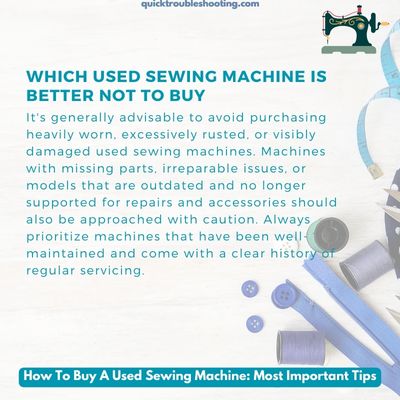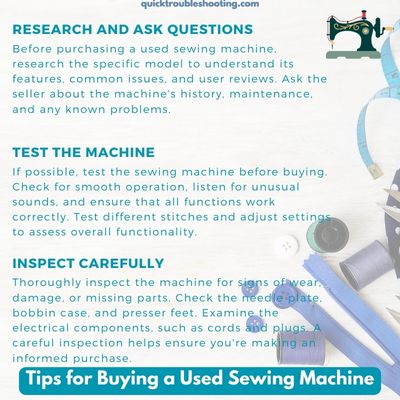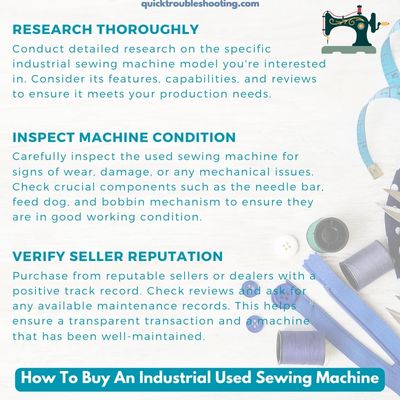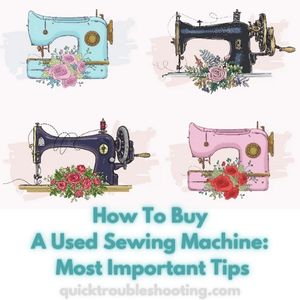How To Buy A Used Sewing Machine: Most Important Tips
Discover the essential tips on acquiring a pre-owned sewing machine with our comprehensive guide on “How To Buy A Used Sewing Machine“. Whether you’re a seasoned seamstress seeking an upgrade or a novice embarking on your sewing journey, investing in a new sewing machine can be a significant financial commitment.
While the allure of a brand-new machine is undeniable, opting for a used sewing machine can be a savvy and economical choice. Uncover the key insights and recommendations to make an informed decision on your next sewing machine purchase.

How To Buy A Used Sewing Machine Tutorial
Investing in a used sewing machine is a wise decision that allows you to enjoy the benefits of a reliable and enduring device without breaking the bank. Many reputable brands produce sewing machines that stand the test of time, offering quality performance even after decades.
While the idea of purchasing a used sewing machine might seem daunting, understanding what to avoid and what to seek can lead you to a fantastic machine that becomes a lasting companion in your creative endeavors.
Don’t be afraid to explore the world of used sewing machines – some of the finest models have proven their excellence over the years, making them a viable and cost-effective choice for your sewing projects.
Tips for Buying a Used Sewing Machine
When it comes to acquiring a used sewing machine, strategic considerations can ensure you make a prudent investment that stands the test of time. Follow these detailed tips for buying a used sewing machine:
1. Consider the Types of Sewing:
- Tailor to Your Needs:
- Evaluate your sewing requirements before making a choice.
- Simple sewing tasks benefit from versatile mechanical models.
- For decorative sewing such as quilting or embroidery, prioritize machines with an array of stitch options, including the consideration of computerized models for enhanced functionality.
2. Accessories Included:
- Throat Length and Extension Tables:
- Assess the importance of throat length based on your intended use.
- Extension tables are particularly essential for quilting, providing a more extensive surface area for maneuvering fabric.
- While presser feet can be bought separately, prioritize machines with the appropriate accessories for your specific sewing needs.
3. Set a Budget:
- Strategic Financial Planning:
- Establish a well-defined budget before embarking on your search.
- Conduct thorough research to understand the current market prices for the desired features and models.
- Recognize that used machines often present a cost-saving opportunity, typically ranging from 30% to 40% less than their original prices, with room for negotiation.
4. Assess the Condition:
- Thorough Examination:
- Test the machine to ensure its functionality aligns with your expectations.
- Inspect features, paying attention to the overall exterior condition.
- Negotiate the price considering any repairs that may be required.
- Exercise caution if you notice buzzing, clicking sounds, cracks, rust, or other potential signs of damage.
5. Brands of Used Sewing Machines:
- Reliability Matters:
- Opt for well-known brands that are still actively in production.
- Trustworthy brands like Brother, Baby Lock, Bernina, Janome, Pfaff, Juki, and Singer have proven track records.
- Avoid models that are out of production, as sourcing parts for repairs may become challenging over time.
6. Try Before Buying:
- Hands-On Evaluation:
- Prioritize testing the machine before committing to the purchase.
- Ensure the machine operates smoothly without unusual sounds.
- Thoroughly check for external damages, and examine the motor’s performance.
- If purchasing online, request a video demonstration to assess the machine’s condition remotely.
7. Get a Complete Package:
- Comprehensive Inclusions:
- Confirm that all original parts are included in the purchase.
- Look for extra accessories such as bobbins, presser feet, instructional manuals, and other vital components.
- Having a complete package not only ensures cost savings but also guarantees the machine’s full functionality.
- Essential parts to verify include bobbins, bobbin cases, presser feet, foot pedal, accessory tray, seam ripper, needles, manual, DVD, and the receipt for reference.

How To Buy An Industrial Used Sewing Machine
When considering the purchase of an industrial used sewing machine, especially if you’re engaged in daily and extensive sewing for personal use or business, strategic steps are crucial. Follow these guidelines to find the right industrial sewing machine for your needs:
1. Identify Your Sewing Needs:
- Detailed Project Assessment:
- Analyze the intricacies of your daily sewing tasks, including the specific patterns and projects you frequently undertake.
- Recognize that industrial sewing machines are tailored for distinct purposes, emphasizing the importance of a detailed understanding of your requirements.
2. Look for Purpose-Specific Machines:
- Customized Machine Selection:
- Understand that industrial sewing machines are not one-size-fits-all; they are designed for specific applications.
- If your sewing projects involve heavy-duty tasks, focus your search on previously used machines specifically engineered for such demanding workloads.
3. Verify Settings Match Your Requirements:
- Configurations for Optimal Performance:
- Conduct a meticulous examination of the machine’s settings before finalizing your purchase.
- Ensure that the configurations align precisely with your desired outcomes, facilitating efficient and effective use in your daily sewing endeavors.
4. Set a Budget in Advance:
- Financial Planning for Precision:
- Establish a clear and realistic budget before delving into the industrial sewing machine market.
- Acknowledge that industrial machines typically come with a higher price tag compared to their domestic counterparts, and having a predetermined budget ensures focused and strategic decision-making.
5. Explore Available Options:
- Thorough Market Exploration:
- Recognize the potential rarity of industrial used sewing machines and adopt a diligent approach to your search.
- Explore a variety of sources, including specialized dealers, reputable online marketplaces, and industrial equipment suppliers, to widen your pool of available options.
6. Consider the Machine’s History:
- Insights Through Inquiry:
- Inquire about the machine’s usage history and request maintenance records from the seller.
- Gaining insights into the machine’s past provides valuable information regarding its durability, performance, and potential longevity.
7. Test the Machine:
- Hands-On Evaluation:
- Whenever possible, conduct a thorough testing of the industrial sewing machine before committing to the purchase.
- Assess its functionality, stitch quality, and overall condition to ensure it aligns with your expectations and can handle your intended workload effectively.
8. Seek Expert Advice:
- Professional Guidance:
- If uncertainties arise, seek advice from industry experts or professionals familiar with industrial sewing machines.
- Their experience and insights can guide you toward selecting the most suitable machine based on your unique sewing requirements and expectations.
9. Check for Warranty and Support:
- Securing Post-Purchase Assurance:
- Inquire about available warranty options or after-sales support for the used industrial sewing machine.
- Having a safety net in terms of warranty can be particularly valuable in case issues arise post-purchase, ensuring ongoing support for your investment.

Where to Buy a Used Sewing Machine
When it comes to finding the perfect used sewing machine, where you choose to make your purchase can significantly impact the quality and longevity of your investment. Explore the following detailed options for acquiring a used sewing machine:
1. Refurbished Machines:
- Many reputable brands in the market refurbish returned sewing machines, offering them at a significantly reduced price.
- These machines often undergo meticulous repairs, making them a reliable and cost-effective option.
- Choosing brands with a strong customer trust factor ensures you’re investing in a quality piece that has been repaired and maintained to industry standards.
2. Friends and Family:
- Tap into your immediate circle by asking friends and family if they have any unused or old sewing machines.
- Friends who sew may have upgraded to newer models, and you could acquire a well-cared-for machine at a reasonable price.
- This not only provides a chance for a budget-friendly purchase but also ensures you are getting a machine that has been appreciated and maintained by someone you know.
3. Online Platforms:
- Explore various online platforms where used sewing machines are available for purchase.
- Online auction sites and marketplaces allow you to bid on machines or negotiate prices with sellers.
- Exercise caution and thoroughly inspect the machine through videos or photos provided by the seller.
- Don’t hesitate to negotiate the price to ensure you are getting a fair deal.
4. Brand Official Websites:
- Check official websites of sewing machine brands for potential used options.
- Brands often have refurbished or pre-owned sections where you can find reliable machines.
- Engage with the brand’s sales representatives to get personalized assistance in finding the best used sewing machine for your specific needs.
5. Local Sewing Machine Shops:
- Explore local sewing machine shops that may carry a selection of used machines.
- Shop owners may have insights into the history and condition of the machines they sell.
- This option allows for hands-on inspection before making a purchase.
6. Sewing Machine Repair Shops:
- Contact sewing machine repair shops, as they sometimes sell refurbished or used machines.
- Professionals in these shops can provide information on the condition of the machines and any repairs conducted.
7. Community Bulletin Boards or Classifieds:
- Check community bulletin boards or online classifieds in your local area for individuals selling used sewing machines.
- This grassroots option may lead to finding hidden gems and striking deals within your community.
8. Garage Sales and Flea Markets:
- Explore garage sales and flea markets for potential used sewing machine discoveries.
- Prices at these venues are often negotiable, providing an opportunity for cost-effective purchases.
By considering these diverse options, you can increase your chances of finding a high-quality used sewing machine that aligns with your needs and budget. Remember to exercise diligence in your research, whether purchasing online or through personal connections, to ensure a satisfactory and durable investment.
Online Platforms for Buying Used Sewing Machines: A Buyer’s Guide
| Platform | Description |
|---|---|
| eBay | A popular online marketplace for new and used items, including sewing machines. |
| Amazon | Besides selling new products, Amazon also has a marketplace for used items, including sewing machines. |
| Etsy | An online marketplace known for handmade and vintage items; you can find vintage sewing machines here. |
| Craigslist | A local classifieds website where you can find used sewing machines listed by individuals in your area. |
| Facebook Marketplace | A platform within Facebook where users can buy and sell items locally, including sewing machines. |
| Gumtree | An online classifieds and community website where you can find used sewing machines, particularly in the UK, Australia, and South Africa. |
| OfferUp | A mobile marketplace for local buyers and sellers; you can find used sewing machines listed by individuals in your area. |
| Letgo | A mobile app for buying and selling locally; users often list sewing machines for sale. |
| Thrift Stores’ Online Platforms | Some thrift stores, like Goodwill, have online platforms where they sell used items, including sewing machines. |
| Sewing Forums and Communities | Websites or forums dedicated to sewing enthusiasts often have sections for buying and selling used sewing machines. Examples include PatternReview and SewingDiscussion. |
| Local Buy/Sell Apps | Depending on your location, there might be specific local apps or websites where people buy and sell used items. |
When buying a used sewing machine online, be sure to ask the seller detailed questions about the machine's condition, maintenance history, and any issues it may have. Check the seller's ratings or reviews if available and consider meeting in a safe, public place for local transactions. Always use caution and common sense when making online purchases.
Conclusion: How To Buy A Used Sewing Machine
In conclusion, purchasing a used sewing machine can be a rewarding endeavor if approached with careful consideration and strategic planning. By understanding your specific sewing needs, exploring various sources such as refurbished machines, seeking recommendations from friends and family, leveraging online platforms, and engaging with reputable brands and local shops, you can secure a reliable and cost-effective sewing machine.
Remember to assess the machine’s condition, history, and settings, setting a realistic budget, and exploring multiple avenues to find the perfect fit for your sewing projects. With these guidelines, you can confidently navigate the market and make a well-informed decision, ensuring that your investment in a used sewing machine stands the test of time.
